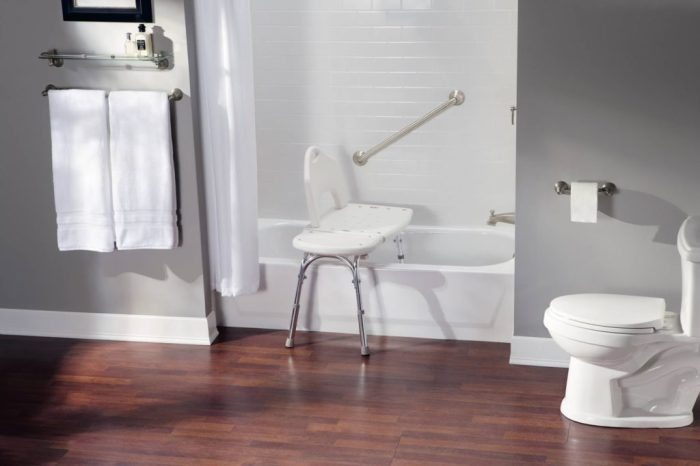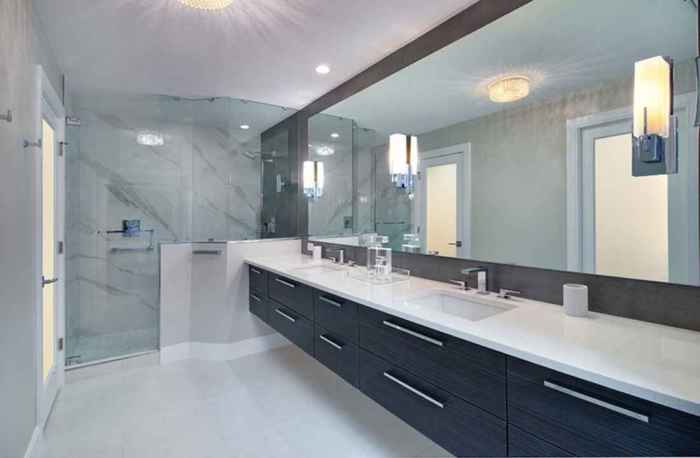As we age, it becomes increasingly important to ensure our homes are safe and accessible. One of the most important areas to consider is the bathroom, where falls and injuries are common. Bathroom floor renovation for aging in place can help to create a safer and more comfortable environment for seniors, allowing them to maintain their independence and quality of life.
In this guide, we will provide a comprehensive overview of bathroom floor renovation for aging in place. We will cover everything from design considerations to materials selection to step-by-step installation instructions. We will also provide tips on how to incorporate universal design principles into your bathroom layout and discuss additional considerations such as lighting and storage.
Bathroom Design Considerations for Aging in Place
As we age, our physical abilities may change, making it important to create a safe and accessible bathroom that meets our changing needs. Universal design principles, which focus on creating spaces that are usable by people of all ages and abilities, can be incorporated into the bathroom layout to enhance safety and comfort.
Grab Bars
Grab bars provide additional support and stability, reducing the risk of falls. They should be installed near the toilet, shower, and bathtub, and should be securely fastened to the wall.
Non-Slip Flooring
Non-slip flooring helps prevent slips and falls. It is important to choose a flooring material that provides good traction, even when wet.
Accessible Showers
Accessible showers feature a curbless entry, making it easy to enter and exit the shower. They may also have a built-in seat and grab bars for added safety.
Materials and Products for Bathroom Floor Renovation
When selecting flooring materials for an aging-in-place bathroom, durability, slip resistance, and comfort are paramount. Let’s explore suitable options and their unique benefits:
Durable and Slip-Resistant Flooring Materials
-
-*Vinyl Flooring
Resilient and waterproof, vinyl comes in a range of styles and textures, providing excellent slip resistance.
-*Tile Flooring
Ceramic or porcelain tiles are highly durable and easy to clean, with options featuring textured or non-slip surfaces.
-*Laminate Flooring
While not waterproof, laminate flooring offers a slip-resistant surface and is resistant to scratches and wear.
Anti-Fatigue Mats
For added comfort, anti-fatigue mats can be placed in areas where individuals stand for extended periods.
These mats provide support and reduce stress on joints, muscles, and feet. Consider placing them near the sink, shower, or toilet.
Step-by-Step Guide to Bathroom Floor Renovation
Bathroom floor renovation is a crucial aspect of aging-in-place modifications. To ensure a safe and accessible bathroom, follow these steps for a successful renovation.
Before starting, ensure you have the necessary tools, materials, and safety gear. Safety glasses, gloves, and a dust mask are essential to protect yourself from debris and fumes.
1. Preparation
- Remove all fixtures, including toilets, vanities, and shower units.
- Protect walls and fixtures from dust and debris with plastic sheeting or drop cloths.
- Turn off the water supply and disconnect any electrical connections.
- Remove the old flooring carefully, using a pry bar or a flooring removal tool.
2. Subfloor Preparation
- Inspect the subfloor for any damage or unevenness. Repair any issues as needed.
- Level the subfloor using a self-leveling compound if necessary.
- Install a moisture barrier, such as a vapor barrier or a waterproofing membrane, to prevent moisture from damaging the new flooring.
3. Flooring Installation
- Choose a flooring material that is durable, slip-resistant, and easy to clean.
- Follow the manufacturer’s instructions for installing the new flooring.
- Secure the flooring properly using nails, screws, or adhesive, depending on the type of flooring.
4. Finishing
- Install baseboards or moldings to cover the edges of the flooring.
- Caulk around the edges of the flooring to prevent water damage.
- Reinstall the fixtures and connect the water and electrical supply.
Additional Considerations for Bathroom Floor Renovation
As we age, certain modifications to our living spaces can enhance safety, comfort, and accessibility. When renovating a bathroom floor for aging in place, additional considerations beyond materials and installation techniques are crucial to ensure a functional and safe space.
Two key aspects to consider are proper lighting and ample storage solutions. These elements can significantly improve visibility, safety, and accessibility within the bathroom, making it more user-friendly for individuals with age-related challenges.
Lighting
Adequate lighting is essential for aging individuals in the bathroom, as it enhances visibility and reduces the risk of falls or accidents. Incorporating both natural and artificial light sources is recommended.
- Natural Light: Large windows or skylights can provide ample natural light, reducing the need for artificial lighting during the day. Consider positioning fixtures near windows to take advantage of natural illumination.
- Artificial Lighting: Artificial lighting should be bright enough to illuminate all areas of the bathroom, including the shower or bathtub. Use a combination of overhead lighting and task lighting (such as vanity lights) to ensure adequate illumination at different levels.
- Motion-Activated Lighting: Motion-activated lighting can be particularly useful for nighttime bathroom visits, providing hands-free illumination when entering or leaving the space.
Storage Solutions
Adequate storage solutions can improve accessibility and organization within the bathroom, making it easier for aging individuals to reach and retrieve essential items. Consider the following:
- Open Shelving: Open shelves provide easy access to frequently used items, such as towels, toiletries, and medications. Position shelves at accessible heights for seated or standing individuals.
- Pull-Out Drawers: Pull-out drawers offer convenient access to items stored in lower cabinets or under the sink. They can be customized with dividers or organizers to keep items separated and easily identifiable.
- Wall-Mounted Storage: Wall-mounted storage units, such as medicine cabinets or towel racks, can provide additional storage space without taking up floor area. They can be placed at accessible heights for easy reach.
Outcome Summary
By following the tips and advice in this guide, you can create a bathroom that is both safe and stylish, and that will meet the needs of aging individuals for years to come.



